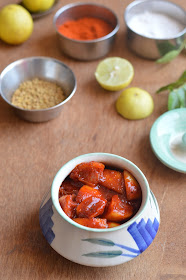Pickles are an integral part of Indian households and so it
is at our home. A proper South Indian meal is incomplete without the customary
Thayir Sadam (curd rice) and oorugai. My MIL is an expert when it comes to
pickling. Not only our family, but anyone who visits our home and tastes her
pickles doesn’t go without asking her for its recipe. Among all
the pickles she makes, my favorite is Avakkai and Vadu Mangai. I hope to post
these recipes this summer.
Now, is the season for lemons. I am not a huge fan of lemon
pickle. But the one I am sharing today is an exception. I learnt this from my
grandmother. The USP of this pickle is that it does not use oil. The salt and
sugar act as preservatives. Please don't panic! It is not a sweet pickle. The sugar just balances the sourness of the lemon. It tastes really good and is perfect with a bowl of
curd rice.
What you'll need
- Indian Lemon – 15 medium sized
- Red Chilly Powder – 1/3 + 1/8 cup
- Salt – 1/3 + 1/8 cup
- Sugar 1/3 + 1/8 cup
- Fenugreek – 1 tbsp
- Asafoetida – ½ tsp
Method
- Wash and wipe the lemon well. Let it dry well.
- Cut 12 of the lemons into quarters or cut each into 8 pieces. I had approximate 2.5 cup of cut lemon pieces.
- Squeeze and extract the juice from the remaining 3 lemons.
- Transfer the lemon pieces into a wide glass bowl, add the measured quantities of red chilly powder, salt and sugar. Also add the lemon juice. Mix well.
- Scrape the sides of the bowl.
- Now, heat a small frying pan, dry roast the fenugreek seeds until they start to pop. Transfer to a plate. To the hot pan add the asafoetida powder fry for few seconds.
- Grind the roasted fenugreek seeds with the help of a mortar and pestle.
- Add the fenugreek powder and asafoetida to the pickle mixture. Stir well.
- Cover with a lid and keep aside.
- Keep stirring once everyday. Transfer to a clean and sterilized bottle after about 10 days.
- Let it sit at least for a month before consuming by when lemon would have become soft and would have absorbed all the spices well.
Note:
- Select firm yellow, thin skinned lemon. Make sure there are no black spots or soft spots on the lemon.
- Always use a clean and dry spoon.
- Keep stirring it once everyday, with a clean dry spoon for at least 10 days.
- Store in clean sterilized glass bottle. I recommend, washing the bottle with soap water and then rinsing it with hot water. And dry in sunlight before storing the pickle.








